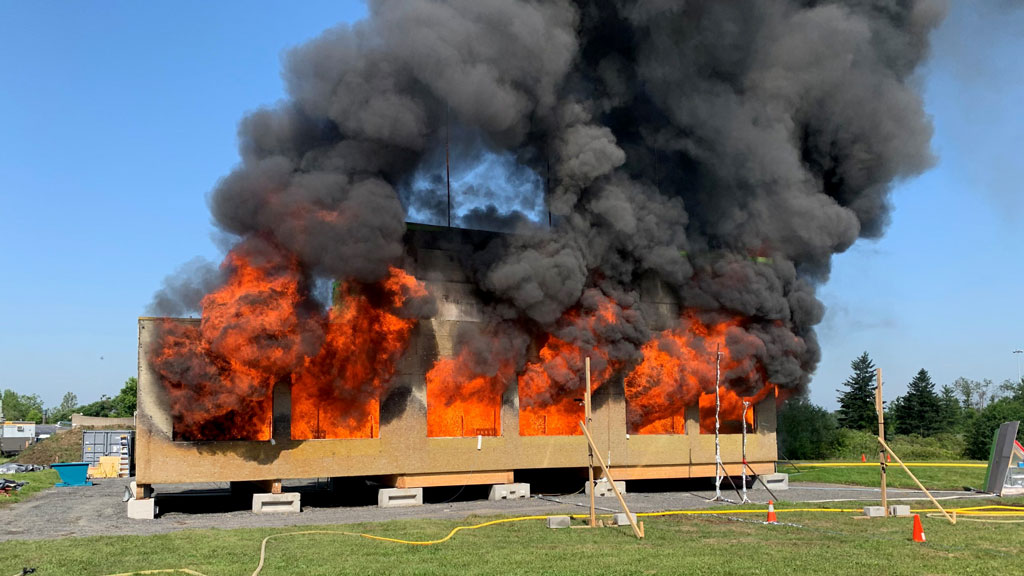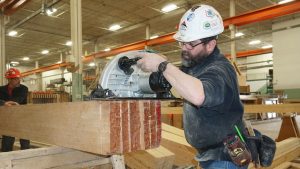Mass timber construction continues to gain momentum across Canada largely because it is eco-friendly and extensive research has validated the fire safety of the material for taller buildings.
That’s the opinion of Shawn Keyes, executive director of WoodWorks BC, and Marc Alam, senior manager, codes and standards – fire and acoustics, at the Canadian Wood Council (CWC).
“Mass timber construction continues to gain momentum in B.C. and across North America for many reasons, but it is mass timber’s fire performance that is allowing for taller and larger buildings to be built out of wood,” says Keyes. “Mass timber construction offers a new way of building structures greater than six storeys with a material that is less carbon intensive than steel or concrete.
“Increased use of mass timber construction offers a more sustainable approach to increasing urban density and will be critical to helping fight the climate and housing emergencies.”
Statistics show the number of mass timber projects across Canada has steadily risen.
So far, 689 have been completed, 76 are under construction and 67 are in the planning stages. Of the 832 mass timber projects, B.C. leads the way with 355 followed by Quebec at 221 and Ontario at 151.
Keyes says the future of mass timber looks promising and he expects more suppliers and manufacturers will come on board as the benefits of building with wood become better known.
In B.C., key drivers are the ongoing housing crisis, global warming, a desire to use lower-carbon materials and support the local forestry economy, says Keyes.
“Building with wood has much lower embodied carbon. It also has the ability to store sequestered carbon. That’s really a key driver of why we’re seeing a lot of uptick and interest.”
Mass timber is a safe construction material
The use of mass timber received a boost recently with the release of findings from large-scale mass timber demonstration fire tests that were led by the CWC in partnership with industry associations, federal and provincial government agencies, and fire safety and engineering consultants.
The tests solidified the use of mass timber as a safe construction material and showed that even in rare worst-case fire scenarios where sprinklers have failed and fire fighters are unable to reach a blaze, mass timber buildings perform similarly to noncombustible construction.
Five separate tests of mass timber structures were conducted by the National Research Council of Canada in summer 2022.
The experiments were conducted within a full-scale, two-storey, 334-square-metre mass timber structure at the Canadian Explosives Research Laboratory in Ottawa. They were conducted without sprinklers and without firefighting intervention for extended hours.
The findings showed in severe, unsprinklered fire conditions with exposed structural mass timber, the test structure remained stable and solid after enduring each of the five different fire tests of varying severity and duration, with an overall incremental total of 19 hours of fire exposure.
The tests enabled new scientific data to be gathered on the fire performance of mass timber in an open plan office and residential buildings, and during construction, in order to determine the influence of exposed mass timber on fire severity and duration. The data is important as it will assist in guiding the fire safety design and solutions for tall and large mass timber buildings.
Fire testing results ‘a clear justification for code changes’
Alam of the CWC says the findings were not a surprise as they bolster data from previous research, but they do provide more support for changing building codes to allow taller mass timber buildings.
“The results from this series of five full-scale fire tests provide a clear justification for code changes that allow for larger and taller mass timber buildings, as well as an increase in the amount of mass timber permitted to be exposed.”
Specifically, the research found the average char depths in exposed mass timber members of buildings were well within the design allowance for structural members of two-hour fire-resistance rating in all five tests.
Meanwhile, the buildings were still intact after the tests.
“We knew about the charring of wood and how it affects the fire resistance and everything, but it is a key finding to understand that in a real fire scenario the char amount, the char accumulation, is significantly less than a standard fire scenario,” says Alam. “So, when we look at char as a standard, we look at fire resistance rating, and with that four-hour real fire scenario it was less than a two-hour standard fire scenario that is required for buildings up to 12 storeys.”
According to the research, some exposed cross-laminated timber ceiling experienced localized delamination in the cooling period during the tests but it did not cause any re-ignition or fire regrowth.
Deep-seated hot spots and smouldering remained after the tests, so firefighting operations were required to ensure they were fully extinguished. Conditions of a stairwell were not adversely affected in any of the tests.
Testing of mass timber buildings has been going on for many years and similar results have been reported in previous research done by the American Wood Council, the Research Institute in Sweden, and in other jurisdictions like Australia and across Europe, according to Alam.






Recent Comments